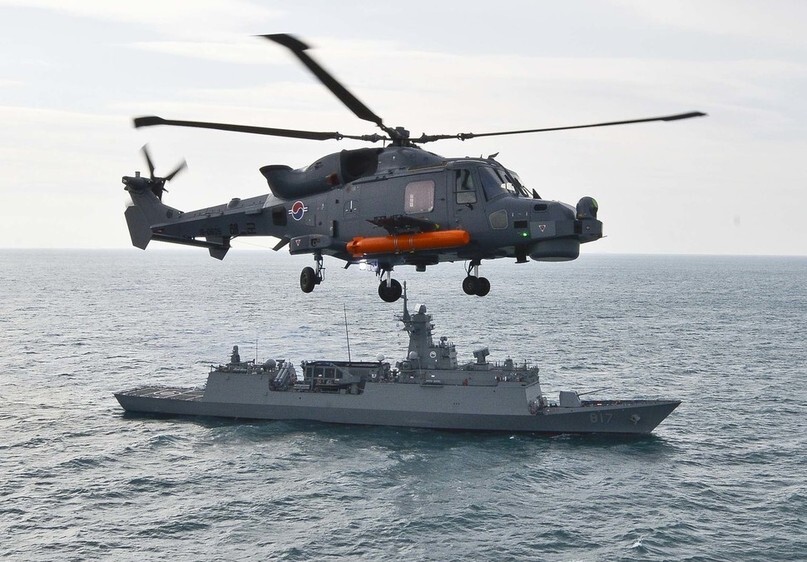hankyoreh
Links to other country sites 다른 나라 사이트 링크
Maritime operation helicopter grounded after defects discovered

An abnormality detected in the AW-159 Wildcat maritime operation helicopter, which was used for patrol flights until November 2019, has been attributed to fatigue-based cracking in its vibration damper.
“On Nov. 23, 2019, damage occurred to the vibration damper on an AW-159 maritime operation helicopter. Flights by the model were suspended, and all units were examined with the manufacturer and experts to determine the cause and the possibility of the same phenomenon occurring again,” the South Korean Navy explained on Jan. 3.
“The investigation showed that the damage to the affected helicopter had occurred due to fatigue-based cracking,” it said.
The Navy planned to resume flights as of Jan. 3, 2020, for all seven of the helicopters besides the one in which the problem was observed. The damper connects the helicopter’s blades with its body and serves to absorb vibrations to prevent shuddering of the fuselage.
At around 12:10 pm on Nov. 23, 2019, a Wildcat made a precautionary landing at a military base after vibrations that occurred while it was performing operations. The design life for a damper is typically around 1,000 hours -- but the one in which the problem occurred had reportedly only been used for around 300. That same afternoon, the Navy issued an order to ground all eight Wildcat helicopters, including the one in which the vibration was observed.
In its explanation on Jan. 3, the Navy announced plans to continue investigating the matter with the manufacturer to determine why fatigue-based cracking occurred so soon within the operational period.
“No irregularities occurred with the fuselages of the other seven helicopters [besides the one in which the vibration occurred],” a Navy official said.
“Going forward, the Navy plans to intensify its safety inspections and operation rules for the model’s fuselage and operate them under rigorous flight safety measures,” the official added.
The AW-159 is a maritime operation helicopter used on destroyers and frigates. It includes state-of-the-art detection equipment and weapon capabilities for attacks on warships and submersibles, including the Spike anti-ship missile and the domestically produced Chung Sang Eo (Blue Shark) torpedo. In June 2016, the Navy acquired eight Wildcat helicopters developed with the UK and Italy in order to respond to the threat of North Korean submersibles, with an operational deployment on Feb. 1, 2017.
By Noh Ji-won, staff reporter
Please direct comments or questions to [english@hani.co.kr]

Editorial・opinion
![[Column] Park Geun-hye déjà vu in Yoon Suk-yeol [Column] Park Geun-hye déjà vu in Yoon Suk-yeol](https://flexible.img.hani.co.kr/flexible/normal/500/300/imgdb/original/2024/0424/651713945113788.jpg) [Column] Park Geun-hye déjà vu in Yoon Suk-yeol
[Column] Park Geun-hye déjà vu in Yoon Suk-yeol![[Editorial] New weight of N. Korea’s nuclear threats makes dialogue all the more urgent [Editorial] New weight of N. Korea’s nuclear threats makes dialogue all the more urgent](https://flexible.img.hani.co.kr/flexible/normal/500/300/imgdb/original/2024/0424/7317139454662664.jpg) [Editorial] New weight of N. Korea’s nuclear threats makes dialogue all the more urgent
[Editorial] New weight of N. Korea’s nuclear threats makes dialogue all the more urgent- [Guest essay] The real reason Korea’s new right wants to dub Rhee a founding father
- [Column] ‘Choson’: Is it time we start referring to N. Korea in its own terms?
- [Editorial] Japan’s rewriting of history with Korea has gone too far
- [Column] The president’s questionable capacity for dialogue
- [Column] Are chaebol firms just pizza pies for families to divvy up as they please?
- [Column] Has Korea, too, crossed the Rubicon on China?
- [Correspondent’s column] In Japan’s alliance with US, echoes of its past alliances with UK
- [Editorial] Does Yoon think the Korean public is wrong?
Most viewed articles
- 1[Column] Park Geun-hye déjà vu in Yoon Suk-yeol
- 2Will NewJeans end up collateral damage in internal feud at K-pop juggernaut Hybe?
- 3Thursday to mark start of resignations by senior doctors amid standoff with government
- 4Why Korea shouldn’t welcome Japan’s newly beefed up defense cooperation with US
- 5‘We must say no’: Seoul defense chief on Korean, USFK involvement in hypothetical Taiwan crisis
- 6[Guest essay] The real reason Korea’s new right wants to dub Rhee a founding father
- 7N. Korean hackers breached 10 defense contractors in South for months, police say
- 8[Column] ‘Choson’: Is it time we start referring to N. Korea in its own terms?
- 9[Editorial] New weight of N. Korea’s nuclear threats makes dialogue all the more urgent
- 10Kim Jong-un expressed ‘satisfaction’ with nuclear counterstrike drill directed at South